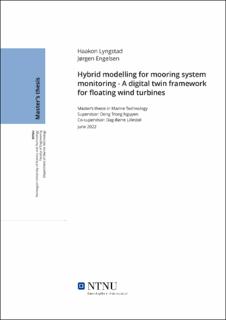| dc.contributor.advisor | Nguyen, Dong Trong | |
| dc.contributor.advisor | Lillestøl, Dag-Børre | |
| dc.contributor.author | Lyngstad, Haakon | |
| dc.contributor.author | Engelsen, Jørgen | |
| dc.date.accessioned | 2022-10-08T17:19:45Z | |
| dc.date.available | 2022-10-08T17:19:45Z | |
| dc.date.issued | 2022 | |
| dc.identifier | no.ntnu:inspera:106583545:37060189 | |
| dc.identifier.uri | https://hdl.handle.net/11250/3024832 | |
| dc.description.abstract | Flytende havvind har potensiale til å være en viktig bidragsyter mot verdens behov for fornybar energi. Vedlikeholds og installasjons kostnader må reduseres for at teknologien skal bli et konkurransedyktig alternativ til andre fornybare energi kilder. I denne masteroppgaven blir et rammeverk for digitale tvillinger foreslått for tilstandsovervåking av flytende vindmøllers forankrings liner. Kostnadsbesparelsene ved å bytte ut spenningsmålere med predikert spenning fra en virtuell sensor modell kan bli betydelige i en stor flytende vindpark.
Oppgaven kombinerer en fysisk modell av forankringssystemet med en datadrevet modell i et forsøk på å skape en robust og presis hybrid modell for prediksjon av topp-spenning i forankringslinene. Den fysiske modellen blir konstruert basert på designkriteriene til Hywind Scotland, mens den datadrevne modellen forsøker å lære hva som er forskjellen mellom den designede og faktiske topp-spenningen.
Den fysiske modellen bruker en kvasi-statisk tilnærming til å estimere topp-spenningen for hver line i ethvert punkt som vindmøllene er i. De datadrevne modellene er basert på tre forskjellige maskinlæringsalgoritmer: Random Forest Regression, Artificial Neural Networks og Long-Short Term Memory networks. Disse algoritmene presenteres for den mer tradisjonelle datadrevne tilnærmingen, og sammenlignes med den hybride modellen som er forslått i denne avhandlingen.
Det foreslåtte digital tvilling rammeverket ble testet på en kasusstudie med operasjonell data fra verdens første flytende vindpark, Hywind Scotland. Hybrid modellen oppnådde en 50% forbedring sammenlignet med den fysiske modellen alene, og en 11% forbedring sammenlignet med den datadrevne modellen.
Resultatene antyder at hybrid modellering har potensiale innenfor tilstandsovervåking av flytende vind og prediksjon av gjennværende levetid. Men en større studie med mer data og flere vind turbiner er nødvendig for å kvantifisere rammeverkets skalerbarhet og nytte. | |
| dc.description.abstract | Floating wind has the potential to become a crucial contributor to the world's need for renewable energy. For the technology to become competitive compared to other energy sources, the cost of installation and maintenance must be reduced. This thesis proposes a digital twin framework for monitoring the mooring system of floating wind turbines. Specifically, it attempts to replace direct tension measurements with a virtual sensor prediction model to monitor accumulated fatigue damage of the mooring lines. In a large wind farm, the cost reductions of transitioning from preventative to predictive maintenance of the mooring systems could be significant.
Using a hybrid modelling approach, this thesis aims to utilise a physics-based model to create a mapping from turbine position to mooring line top tension in "as-designed" condition with a basis in physical understanding of the system. A data-driven model is used to map the difference from "as-designed" to "as-is" condition of the mooring system behaviour. The two models are combined into a hybrid model to create a reliable and accurate prediction of top tension in mooring systems.
For the physics-based model, the mooring line tensions are estimated for each line, at each time step, using quasi-static analysis. The data-driven models are based on three machine learning algorithms: Random Forest Regressors, Artificial Neural Networks and Long-Short Term Memory networks. These algorithms are compared for the more traditional data-driven approach, and for the hybrid approach proposed in this thesis.
The digital twin framework is applied to a case study on the world's first floating wind farm, Hywind Scotland. The proposed hybrid model achieves an average 50% improvement in RMSE from the physical-based models and an 11% improvement compared to the data-driven model.
The results indicate that hybrid modelling may have merits within mooring monitoring and remaining useful life forecasting for floating wind. A case study with an increased amount of data is needed to test the method on a broader range of conditions and evaluate generalising performance and the scalability of the digital twin framework. Further work is proposed to improve upon the hybrid framework presented. | |
| dc.language | eng | |
| dc.publisher | NTNU | |
| dc.title | Hybrid modelling for mooring system monitoring - A digital twin framework for floating wind turbines | |
| dc.type | Master thesis | |
